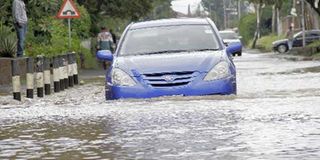5 things to know about El Nino and why Nairobi's bad floods is not it yet

A car navigates floods in Nairobi. The Meteorological Department has said the recent heavy rains received in the city are not caused by El Nino. PHOTO | NATION FILE
What you need to know:
- In East Africa it causes heavy rains during the short rains from October to December.
- The onset of an El Nino event in the Pacific Ocean does not necessarily result in increased rainfall for East Africa
- In the urban areas there is a lot of pavement, tarmac, and buildings. All these prevent water from seeping into the ground and therefore water tends to collect a lot on the surface.
For two consecutive nights in the middle of May the rains pounded Nairobi.
Floodwaters rendered homes unliveable, ruined cars and kept vexed, exhausted commuters on the road until early morning. Schoolchildren were trapped in a school bus, and at least ten people died.
The Meteorological Department acknowledged that this downpour was unusually heavy and varying amounts of rainfall had fallen in different parts of the city.
“Our station here in Dagoretti Corner recorded up to 189mm for the two days. That’s very, very heavy because it’s even more than the long-term average for the whole month of May," said Mr Samuel Mwangi, the Deputy Director of the Kenya Meteorological Department Thursday. “Wilson Airport recorded more than 120mm for the two days.”
These were normal long rains which happen from March to May, he explained, not caused by El Nino.
“We can’t say this has anything to do with the global phenomenon because indeed El Nino has very little relationship with the long rains in Eastern Africa and Kenya for that matter.”
So, how does the recent flooding episode fit in the bigger climate picture?
1) 2015 is an El Nino year
Mr Mwangi made those remarks a day before a US advisory placed chances of El Nino continuing to the end of 2015 at greater than 80 per cent. Australian scientists were also predicting a strong event.
“This will be quite a substantial event. It's not a weak one or a near miss," David Jones of Australia’s Bureau of Meteorology told the Sydney Morning Herald.
El Nino is caused when the waters in the eastern Pacific Ocean off the coast of Peru warm, leading to changes in weather patterns around the world. In East Africa it causes heavy rains during the short rains from October to December, with little influence on the long rains that occur from March to May. The recent storm was destructive, but there could be a worse one ahead.

Chart of abnormal ocean surface temperatures [ºC] observed in December 1997 during the last strong El Niño. Note the high temperature around the coast of Peru (source: National Centers for Environmental Prediction, US).
2) El Nino doesn’t always mean more rain
The onset of an El Nino event in the Pacific Ocean does not necessarily result in increased rainfall for East Africa, according to a Kenyan climate expert. Professor Nzioka Muthama of the University of Nairobi explained that an El Nino event goes through the stages of onset, growth and maturity.
“The El Nino may set on but not grow, or decay before it matures,” he said. If El Nino’s effects were felt in Kenya, not every town would necessarily receive high rainfall.” He also cautioned that due to many uncertainties, it was impossible to predict what would happen six months in advance with good confidence, although a clear rainfall prediction for Kenya was possible from around August.
3) Cities are susceptible
The average temperature in a city is slightly higher than in surrounding areas. This feature, called an urban heat island, can increase the likelihood of storms.
“These buildings not only generate heat, but also capture solar radiation, such that in a built-up area the temperatures are slightly higher than the surroundings.
"Now when this interacts with the atmospheric variables, humidity and so on, it can sometimes enhance convection, and sometimes you see that urban areas sometimes tend to experience some severe storms," said Mr. Mwangi

Clouds gather above the Nairobi city skyline on May 14, 2015. The average temperature in a city is slightly higher than in surrounding areas. PHOTO | JEFF ANGOTE | NATION
Urban areas are also less permeable to water. “In urban areas there is a lot of pavement, tarmac, and buildings. All these prevent water from seeping into the ground and therefore water tends to collect a lot on the surface,” Mr Mwangi explains. "Buildings and walls inhibit the natural flow of water, making flooding more serious than it would otherwise be".
4) El Nino and La Nina have been costly
The 1997-1998 El Nino which is still regarded as the strongest event yet, was particularly destructive:
It was estimated that 300 people died from drowning, according to a UN report.
The estimated cost to roads and bridges was $670 million. Docking facilities were submerged in floodwaters and offloading cargo from ships was impossible as a result. Other losses included widespread landslides, soil erosion and breakage of small dams.
$8.9 million was spent on chemicals for water treatment and repair of water supply facilities damaged during El Nino.
Total losses in the agricultural sector were estimated at $236 million, There was massive loss of livestock, with 1,000,000 goats, 170,000 cattle and 800,000 sheep lost. Total livestock losses were valued at more than $113,000,000.

A photo in the Daily Nation on January 27, 1998 shows an oil tanker negotiating what remained of Kambu Bridge, Mombasa, after it was swept away by floods. The estimated cost to roads and bridges damaged by the El Nino rains was $670 million. PHOTO | NATION ARCHIVES
5) El Nino means rain. La Nina means drought
El Nino and La Nina are the warm and cold phases of the same phenomenon, the El Nino Southern Oscillation (ENSO). While El Nino is caused by warming of waters in the eastern Pacific, La Nina is caused by cooling of waters in the same part of the world. In East Africa, La Nina usually leads to drought during the ‘short rains’ season.
Since Kenya’s independence in 1963, two especially strong El Nino events have been recorded, in 1982 and 1997. The devastating 2011 drought which spawned a nationwide fundraising effort in Kenya was partly due to La Nina.





